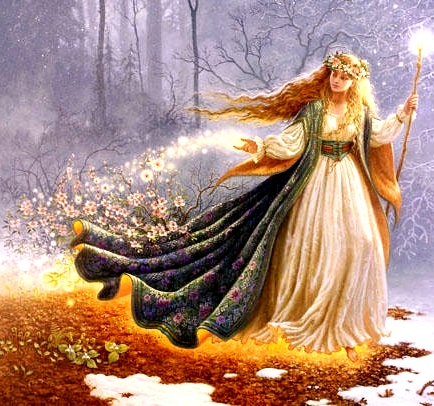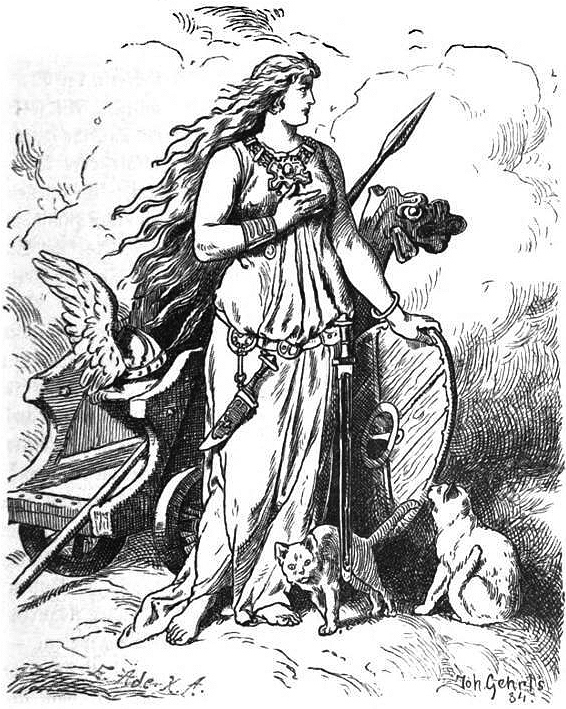Welcome to the first in my goddess series, where I’m diving into the mythology and lore of the goddesses honored around the world. I wanted to start this off with one of the few known goddesses from Norse mythology, Freya.

Freya is a goddess of love, battle, sex, war, wealth, beauty, death, healing, and magic. Seem controversial? She is!
In Norse mythology, there are two main sects of gods and goddesses, the Vanir and the Aesir. Freya belonged to the Vanir and was a Priestess of the Seidr, the most powerful of all Norse witchcraft. A nomad at heart, Freya roamed the countryside sharing her powerful magic. Extremely generous, Freya shared her magic even in Asgard, the home of the opposing deity faction, the Aesir. Unfortunately, the Aesir did not appreciate the gift Freya bestowed upon them. “The Aesir were quite taken by her powers and zealously sought her services. But soon they realized that their values of honor, kin loyalty, and obedience to the law were being pushed aside by the selfish desires they sought to fulfill with the witch’s magic. Blaming Freya for their own shortcomings, the Aesir called her “Gullveig” (“Gold-greed”) and attempted to murder her.”[1] After torturing her, the Aesir bound her and set her on fire. The aesir successfully killed her but they underestimated her power. Freya was reborn. Again, they pierced her skin, tortured, and burned her, and still she was reborn. A third time, and still she was reborn and finally escaped. Enraged by the Aesir’s atrocities, the Vanir deities wanted revenge. They demanded the Aesir hand over one of their own powerful goddesses equal to Freya. Probably lacking any goddess equal to Freya (I opine), the Aesir, of course, refused. They retorted that Freya had come into Asgard ranting about “Gold, gold, GOLD! It was all she talked about.”[2] Freya had not been obedient to the Aesir and now, having thrice tortured and killed her, were blaming their victim. These events set into motion a monumental war between the Aesir and Vanir. There are many stories to tell about that war but for now, suffice to say, the two sides eventually called a truce, when Freya went to live in Asgard and was made an honorary member of the Aesir!

As the goddess of love, sex, and fertility, Freya is open and unabashed in her sexuality. Many of the stories about Freya feature her sexual exploits. One of the best known stories about Freya is the story of the Brisingamen necklace. The story goes that Freya, in her travels, happened upon four dwarves who possessed this beautiful necklace, the Brisingamen necklace. We already know Freya has often been thought to be somewhat of a “gold-digger.” Well, as the story is often told, Freya had an immense desire for this exquisite necklace. Instead of selling it to her for gold or silver, the dwarves wanted four nights alone with the Goddess. Freya agreed and that is how she acquired the necklace. Simple story, right? Let’s take a closer look. In Norse Mythology, four dwarves are known to represent the four elements – earth, water, fire, and air. “As Freyja slept with each in turn, she gained knowledge of each direction… This wisdom allowed her to embody the essence of life, taking it into herself and claiming it as her own. Freyja’s vast life-giving and revitalizing power is undoubtedly the reason that numerous giants try to steal her or coax her into marriage and the reason that Loki (the Norse god of cunning and mischief) tries to steal her necklace for Odin. Freyja’s power is stored in her necklace, as well as in her body.”[3] In fact, “…the Old Norse root brisingr refers to both ‘fire’ and ‘amber,’ it may be that her task was to gather and return streaming sunlight to the world at the end of a dark, northern winter. In essence, she encircles the Earth to bring back the circle of the Sun, represented by the circle of her necklace.”[4]
In The Poetic Edda, an ancient Nordic saga, Freya is at a party with the Aesir gods, a party to which Loki was not invited. Effectively “crashing” the party, Loki shows up, uninvited as he is, and proceeds to insult the gods and goddesses who had failed to invite this god of mischief to their party. When it is Freya’s turn, he turns to slut-shaming, saying:

Be silent, Freyja! For fully I know thee,
Sinless thou art not thyself;
Of the gods and elves who are gathered here,
Each one as thy lover has lain.
Be silent, Freyja! Thou foulest witch…[5]
Despite Loki’s jealous-sounding words here, in another story, Freya, ever generous, offers Loki the use of her cloak of feathers which allows the wearer to shapeshift into a falcon. Freya’s shapeshifting abilities are probably due to her magical powers as a witch and priestess. As the leader of the Valkyries, the supernatural women who collect fallen warriors from the battle fields, her cloak of falcon feathers allows her to swoop in to the battlefield to gather fallen warriors and carry them away to her great hall in the other world.

Freya has a deep connection with animals. From her cloak of feathers, to her chariot pulled by cats, and her boar of golden bristles, these animals often represent the spirit world, thus showing how easily Freya move between the worlds as a witch and a goddess.
Freya is generous, sexy, lethal, forgiving, and
unashamed. She is a priestess, a witch, a goddess, an archetype, a myth, a woman,
femme totale. Her story is familiar to those who have themselves been
slut-shamed, and those whose stories have been mangled by their enemies. Freya
reminds us to take our stories back from our oppressors, to be honest and
unashamed of who we are, to find the magic in connection and harmony, to
forgive, and to love deeply.

[1] https://norse-mythology.org/tales/the-aesir-vanir-war/
[2] http://www.timelessmyths.com/norse/beginning.html#GodWar
[3] Skye, Michelle, Goddess Alive! Inviting Celtic & Norse Goddesses into Your Life (Llewellyn Publications, 2007), p. 77.
[4] Rysdyk, Evelyn C., The Norse Shaman: Ancient Spiritual Practices of the Northern Tradition (Destiny Books, 2016) P. 64.
[5] Henry Adams bellows, trans., The Poetic Edda (Princeton: Princeton University Press, 1936), verses 30 and 32, pp. 161-162.


great blog, thank you.
LikeLike